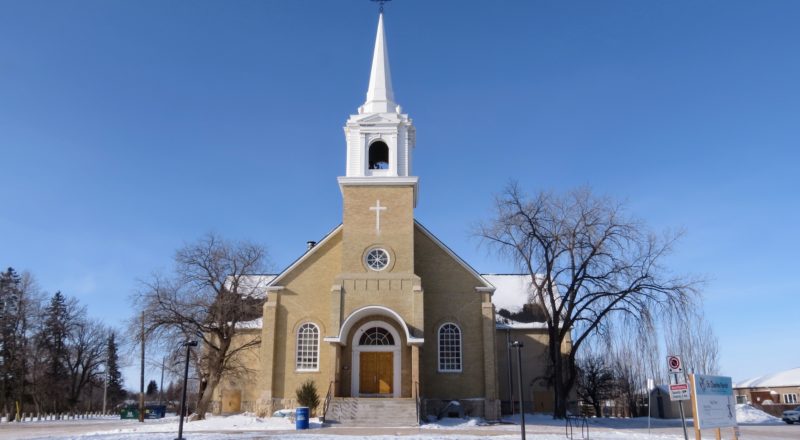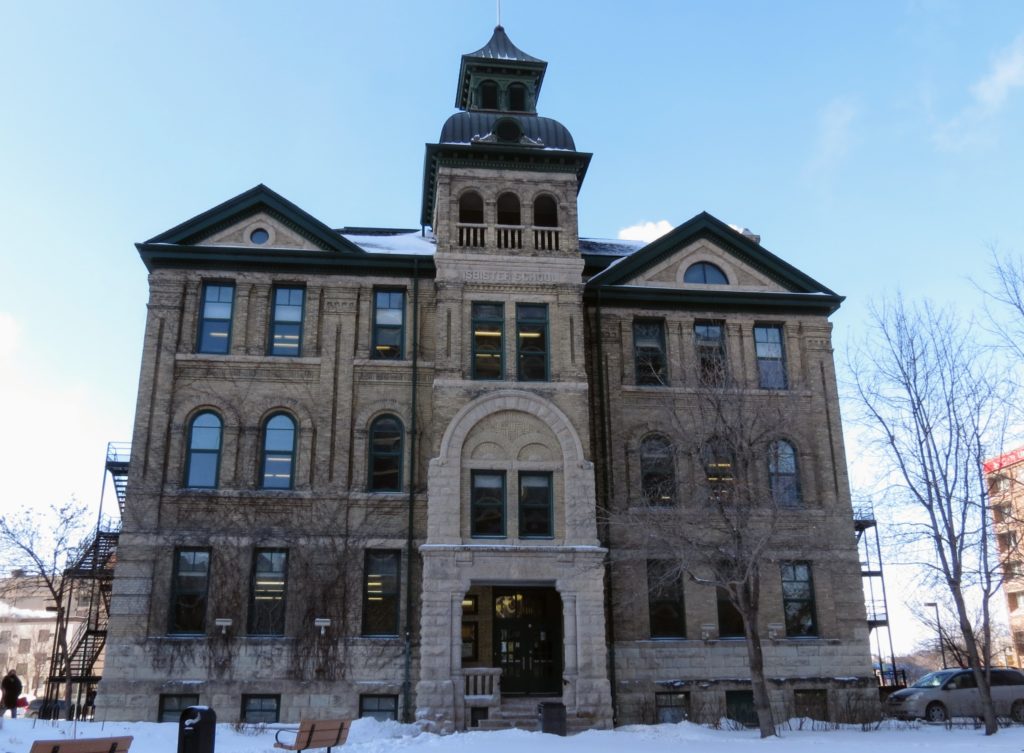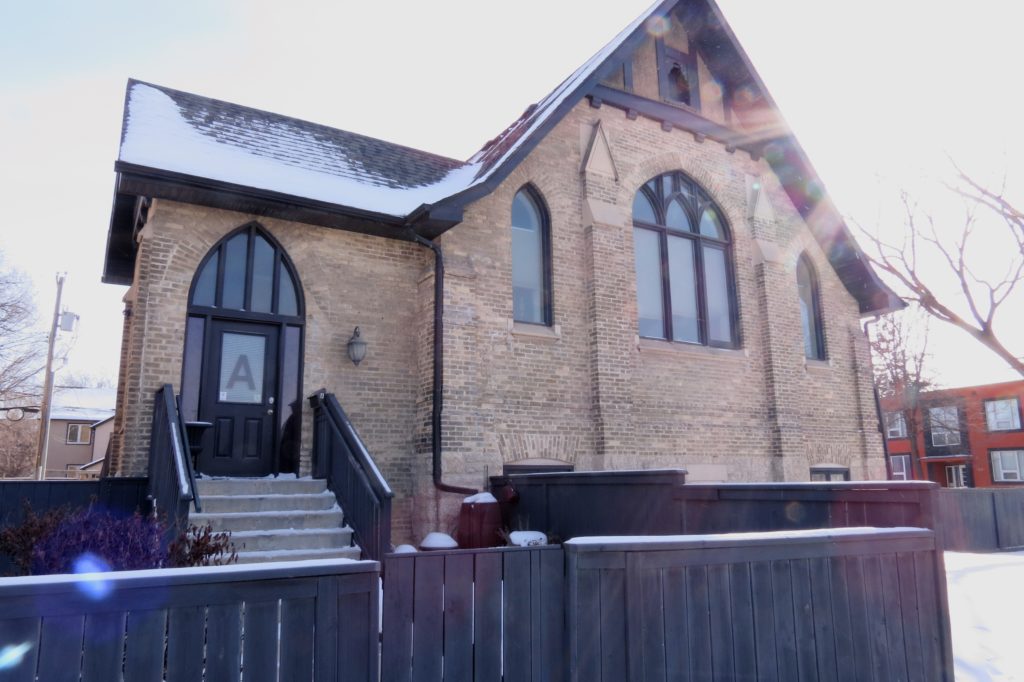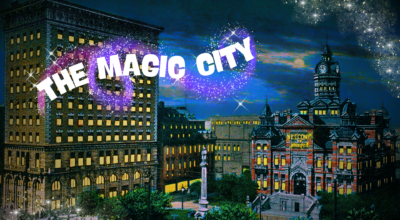
/ Blog
February 24, 2021
Heritage Winnipeg’s Annual Preservation Awards: A Retrospective
Since 1985, Heritage Winnipeg’s Annual Preservation Awards (APA) have been held in mid-February, to coincide with now Louis Riel Day and Heritage Week. The APA’s have recognized conservation excellence in historic commercial and industrial buildings including residential homes throughout Winnipeg, by honouring the dedicated owners, community leaders and professionals that undertake these projects and make them a resounding success!
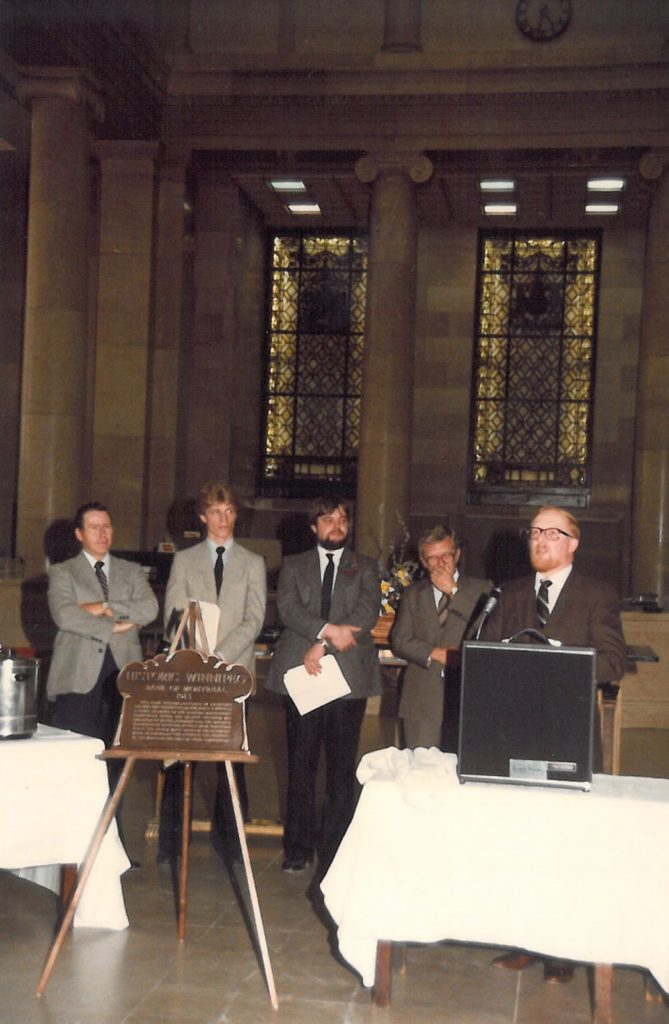
The 1982 Annual Preservation Awards at the Millennium Centre, 389 Main Street.
Source: Heritage Winnipeg Files
Due to the Province of Manitoba’s COVID-19 restrictions, the 2021 Annual Preservation Awards have been postponed until fall, and we at Heritage Winnipeg are left missing the usual buzz of organizing and holding this special event. Still, nominations are open for any heritage conservation projects, and/or individual(s) and community groups under our Distinguished Service Award, or nominate someone for our special Youth Award. If you have a person or project in mind, do not hesitate to nominate them. The form can be found here. Currently nominations are open until June 30th, 2021.
If you, like us, are missing our Awards, join us in taking a look back at some of the over two hundred award winners over the past thirty-six years!
1980s
Dalnavert Museum at 61 Carlton Street
Dalnavert Museum and Visitors’ Centre was one of the first buildings to receive an APA, recognizing the effort put in to restore the historic house back into its original state. Dalnavert was built in 1895 for Sir Hugh John Macdonald and his family. After the Macdonald’s left the home in 1929, it was transformed into a boarding house and the interior was significantly altered. Dalnavert remained a boarding house until the 1960s, when a development company purchased the house with the intention of turning it into a surface parking lot. A group of heritage activists, including the Manitoba Historical Society and other interested professionals, convinced the development company to instead sell the house to them. Under the leadership of architects John Chivers and George Walker, Dalnavert was restored to its original condition and opened as a museum. Dalnavert became a National Historic Site in 1990, and a Municipal Historic Site in 1995. A new addition to be used as an Interpretive Centre, with a universally accessible entrance was added in 2006. Designed by Wins Bridgman, this too earned Dalnavert Museum yet another APA that year.
The Museum’s doors were briefly closed in 2013-2014, until the non-profit group Friends of Dalnavert was formed. Under their management, Dalnavert Museum still operates as a museum and continues to provide engaging educational and community programming and is always a popular building to visit for Doors Open Winnipeg.
The Courtyard at 100 Osborne Street
Another early award APA winner was The Courtyard at 100 Osborne Street. The Courtyard is a recognizable landmark of Osborne Village, with its angled main entrance, red-bricked facade, and clock tower.
Built in 1910 for Hartley M. Millman, the building initially accommodated commercial, office, and residential space within its three storeys. Over the years tenants have come and gone, though little beyond the signage has changed on the modest classical revival exterior. The interior though was altered in 1977, under the supervision of the architecture firm Stecheson, Frederickson, and Katz. The residential suites were removed, and a glass-roofed courtyard was installed. Bridges and walkways span this interior courtyard space, connecting the office and commercial suites left in the building. The Courtyard renovation won an award at Heritage Winnipeg’s 1985 APA ceremony, and more recently in 2019, 100 Osborne Street was designated a municipal heritage structure by the City of Winnipeg.
Many of the building’s tenants today are local businesses ranging from small retail boutiques, a handful of restaurants, and even a salon, with the 111 year old building still playing an important role in the vibrancy of the local community!
St. Charles Church at 320 St. Charles Street
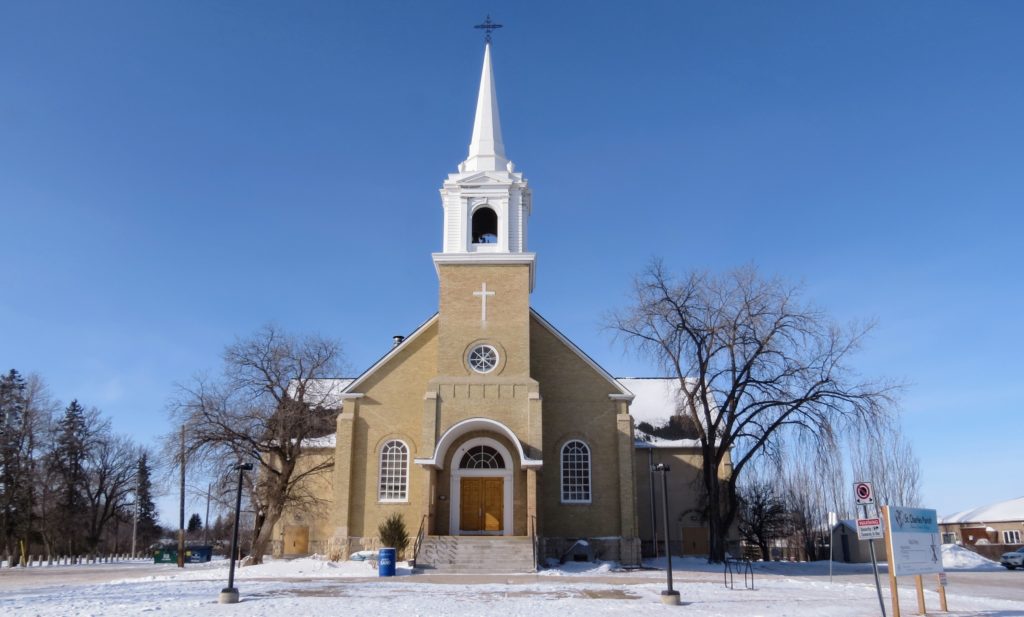
The St. Charles Church in 2021. You can see the 1980s addition in the two wings near the back of the structure.
Source: Sabrina Janke, Heritage Winnipeg
The St. Charles Church has served the St. Charles neighbourhood since the 1850s. At first a small log structure, the church was rebuilt and expanded as the surrounding community grew. The present-day church was built in 1929, after the earlier 1905 Gothic-style church burned down.
In 1987, the church underwent a massive renovation that more than doubled the size of the church. The renovation was sympathetic to the original design, using similar materials and mimicking the classically inspired details on the main body of the church. The Church hired architect Giovanni Geremia, of gw architecture to design a new expansion in 1987, which more than doubled the capacity of the church. The sympathetic design of the new addition seamlessly matches up with the classically inspired architecture of the original building. After a year of work, the church was rededicated in 1988 and received an APA in 1989.
Now over 30 years later, the St. Charles Church still serves the surrounding community.
1990s
Hudson’s Bay Company Garage at 115 Garry Street (The Keg)
Department stores in Winnipeg took up a lot of space in the early 1900s. Outside of the retail space itself, there were warehouses, mail-order buildings, and even parking garages needed to ensure smooth operations. The building at 115 Garry Street was originally a garage built for the Hudson’s Bay Company (HBC) in 1911. Due to its utilitarian purpose, the ornamentation on the building designed by local architects Woodman & Carey is minimal, though there still remains a round window opening with the stylized initials of the HBC.
After the HBC left the building in the 1930s, a number of other companies passed through, mostly automotive-based until the space was converted into a restaurant in 1974. Architects Chandler-Kennedy and consulting Engineers Benjamin Smolensk and Associates oversaw the renovations, which included the removal of the large garage doors and creating new space for seating. Not long after renovations were completed a restaurant moved in, now called the Keg.
A second renovation in 1989 earned the Keg an APA in 1990. Tibbatts & Company Design Group and Cooper Rankin Architects designed a new addition for the restaurant, just behind the relatively new vestibule. The Keg still remains in this building, which was designated a municipal historic building in 2019.
Manitoba Children’s Museum at 45 Forks Market Road

The updated entrance to the Manitoba Children’s Museum in 2019.
Source: Sabrina Janke, Heritage Winnipeg
The opening of the Manitoba Children’s Museum in 1994 was the result of years of hard work and advocacy, and involved a near total transformation of an abandoned CPR train repair building. When the recently founded Children’s Museum then at 109 Pacific Avenue, began to scout for a new location in the 1990s, an abandoned 1890s Canadian National Railway structure likely was not the most obvious fit. Old, decaying, and facing structural issues, the abandoned CNR Bridges and Structures building needed some serious work. With the help of funding from all three levels of government and the financial aid of the Western Economic Diversification Canada and Manitoba’s Culture, and Heritage and Citizenship Department, renovations could begin. Keith Rankin, of Cooper Rankin Architects, oversaw the projects design. The roof was replaced, the foundation repaired, and new exhibits were installed inside. It was a monumental effort, and one that earned the Children’s Museum multiple awards – including an APA in 1995.
A 2012 renovation added a new entrance and an updated interior which continues to entertain and educate children of all ages.
Grey Nuns Convent at 494 Tache Avenue
The Grey Nuns Convent built between 1846-1851, is the oldest surviving building in Winnipeg. Initially, the building provided housing for the Grey Nuns, a group of Catholic missionaries from Montreal who had come to Manitoba in 1844. The convent was built out of oak logs in the Red River Frame technique and served as housing for the Grey Nuns from 1851 until 1956, at which point the City of Winnipeg took ownership. Shortly afterwards, rumours began to swirl that the former convent was to be demolished; the St. Boniface Historical Society (La Société historique de Saint‐Boniface) took action and worked to save the home and turn it into a museum. The Government of Canada designated the Grey Nuns Convent as a National Historic Site in 1958, and agreed with the plan to turn the building into a museum.
After an initial struggle to acquire funding, the St. Boniface Museum (Le Musee de St. Boniface) officially opened in 1970. Twenty years after the museum’s opening, the museum underwent a significant restoration project that cost $1,264,000. Funding came in part from the City of Winnipeg, the federal government, various donations, and the museum’s own funds. Prairie Partnerships and A.F. Eshmade and Associates were hired to oversee the renovations.
The project took two years, from October 1993 to November of 1995, and earned the museum multiple awards – including an APA from Heritage Winnipeg. Additionally, in 1995 the former convent was designated a municipal heritage building by the City of Winnipeg.
The St. Boniface Museum is still in operation and is a popular destination for locals and tourists alike, and has taken part in Doors Open Winnipeg for many years.
2000s
Princess Street Red River Campus at 160 Princess Street
Red River College’s Princess Street Roblin Centre is a familiar sight in the Exchange District. The preserved facades date back to Winnipeg’s boom period at the turn of the 20th century, and have at various times housed the Grain Exchange, the Prairie Theatre Exchange, and a wide variety of commercial ventures. Each of the facades has its own municipal heritage designation.
In the late 1990s, though, the future of these buildings was not guaranteed. Many had been near empty or abandoned for years, and there was a very real threat of demolition. Meanwhile, Red River College was scouting for a location for a downtown campus and eventually settled on the block of Princess Street between William and Elgin Avenue.
With the help of a trilateral funding agreement between the City of Winnipeg, the Province of Manitoba, and the Government of Canada, Corbett Cibinel Architects were able to devise a plan for the campus that kept both the Princess Street facades and numerous interior elements.
Red River College’s Roblin Centre opened in 2004, and earned an APA that same year. Red River College has continued to expand, with a culinary campus in the former Union Bank Tower (504 Main Street), and the ACE Project Space (321 McDermot Avenue).
Isbister School at 310 Vaughn Street
Isbister School is the oldest remaining public school building in Winnipeg, and the last remaining historic school in Winnipeg’s downtown. The ten-room school was built in 1898, and designed in a subdued Queen Anne revival style by architect Samuel Hooper. At the time the surrounding neighbourhood was primarily residential, but over the following century Winnipeg’s downtown landscape began to shift. Other schools in the area were closed and demolished, but the Isbister School remained operational until 1964. In the following three years, it seemed likely the school would be demolished as well, but it was reopened as the Adult Education Centre in 1967. The building was designated a provincial heritage building in 1984.
The Adult Education Centre remains in the building, which is remarkably intact to this day. In 2001, work was undertaken by GBR Architects, and the project subsequently received an APA.
Wilson House at 545 Broadway
Wilson House today is best known as Klinic, which occupied the historic 1904 home from 1977-1990, and again from 2002-2019. The gap in occupation can be attributed to the Wilson House’s deteriorating conditions in the 1990s, and the rapid growth of Klinic as an organization. Charlemore Investments Limited bought the house in 1990, and pushed for Wilson House to be demolished. Instead, the City of Winnipeg designated the building as a Grade III municipal historic building and saved the home from future demolition.
After almost a decade of vacancy, the Lions Club of Winnipeg Housing Centres purchased the home in 1999 and repaired the house. Shortly after, Klinic moved back into the home. Restorations on the exterior continued until 2005, at which point the project won an APA. Klinic continued to operate out of the building for some time, providing invaluable support to many in Winnipeg, but their continued growth prompted them to relocate to Sherbrook Street in 2017.
Currently the Wilson House in home to several non-profits, including the West Broadway BIZ and the Manitoba Harm Reduction Network. Most recently in summer of 2020, there was a successful fundraising effort to establish a permanent accessible Indigenous garden on the grounds of Wilson House.
2010s
The Parish Hall Lofts at 181 Church Avenue
When Cam Dobie, of Dobie Properties first saw the abandoned church at 181 Church Avenue, he described it as “a mess”. Built in 1887, the building had once served as the Parish Hall for St. John’s Anglican Cathedral. According to Dobie, the pipes had frozen and the building was in such bad shape it’s owners were hoping to demolish the building before Dobie Properties purchased it.
Dobie had a big plan for the building; it would be a condominium complex that combined history, green building features, and contemporary touches. All in all, the project took around 18 months and involved gutting much of the interior. The ceilings, columns and pillars were kept while new features were built around them, creating a unique and bright living space. The 7-unit complex was finished in 2010, and won an APA in 2011.
Manitoba Indigenous Cultural Education Centre at 119 Sutherland Avenue
The Manitoba Indigenous Cultural Education Centre is the largest cultural education centre in Manitoba, and is located in the former All Peoples Mission building at 119 Sutherland Avenue. Initially built in 1908, the All Peoples Mission occupied the building until 1977, when the Manitoba Indigenous Cultural Education Centre moved into the building. Over the years the interior has been almost completely altered, and for a time the exterior was covered in white paneling. Despite the alterations, the City of Winnipeg designated 119 Sutherland as a municipal historic building in 2004.
In 2010, the building underwent a massive restoration process that stripped the white siding to reveal the original brickwork underneath. A new bay window was also added, as were numerous interior elements. Bridgman Collaborative Architecture managed the renovation, which won a 2011 APA. The entire building can be viewed online on the Manitoba Indigenous Cultural Education Centre’s website. Today, the Centre’s library holds over 10,000 books and videos, and hundreds of artifacts and works of art. They continue to offer educational programming to the community and have taken part in Doors Open Winnipeg for many years.
St. John’s Library at 500 Salter Avenue
The St. John’s Library was one of three Winnipeg libraries built in the 1910s with funding from the Carnegie Foundation. The St John’s Library opened in 1915, to much excitement. Apparently public demand was so high that the library opened on June 2nd, 1915, with barely any furniture inside. Hundreds of people, local dignitaries, and Mayor Waugh were present at the opening ceremonies as an orchestra provided musical entertainment for the crowds. The library structure itself, like many other Carnegie libraries, is classical in style. It was architect J.N. Semmons who designed the building, relatively earlier into Semmon’s lengthy career in Winnipeg.
More recently, the St John’s Library underwent a significant rehabilitation project. In 2011, the St. John’s Library was designated by the City of Winnipeg and a year later public consultations began for the prospective renovation project. The plan was to create a new accessible entrance to the historic building and to update the space to meet the needs of today’s library users while preserving many of the character defining elements of the structure. Public City Architecture was responsible for the design, which added both the accessible entrance but also reimagined the building’s interior. Construction began in 2017, and the library reopened in 2019.
Upon the library’s reopening, the building was awarded an APA. About 47,000 items are borrowed every year from St. John’s Library, from books to games to DVDs, and the library continues to serve the community.
THANK YOU TO THE SPONSOR OF THIS BLOG POST:

Written by Sabrina Janke on behalf of Heritage Winnipeg.
SOURCES:
Step Back in Time at Dalnavert House
61 Carlton, City of Winnipeg Historical Report
100 Osborne Street, City of Winnipeg Historical Report
115 Garry Street, City of Winnipeg Historical Report
An Industrial Rehabilitation: The Making of the Manitoba Children’s Museum
494 Tache Avenue, City of Winnipeg Historical Report
Hall-Marks The Spot: Winnipeg’s Heritage in Christmas Movies
Designated Heritage: Saving the Past for the Future!
545 Broadway, City of Winnipeg Historical Report.
Healthy Heritage: The Wilson House
Beautiful converts: 1887 church turned into loft-style condo complex (Winnipeg Free Press)
310 Vaughn Street, Province of Manitoba Historic Sites
119 Sutherland, City of Winnipeg Historical Reports
500 Salter Avenue, City of Winnipeg Historical Reports
The New Edition of the St. John’s Library





